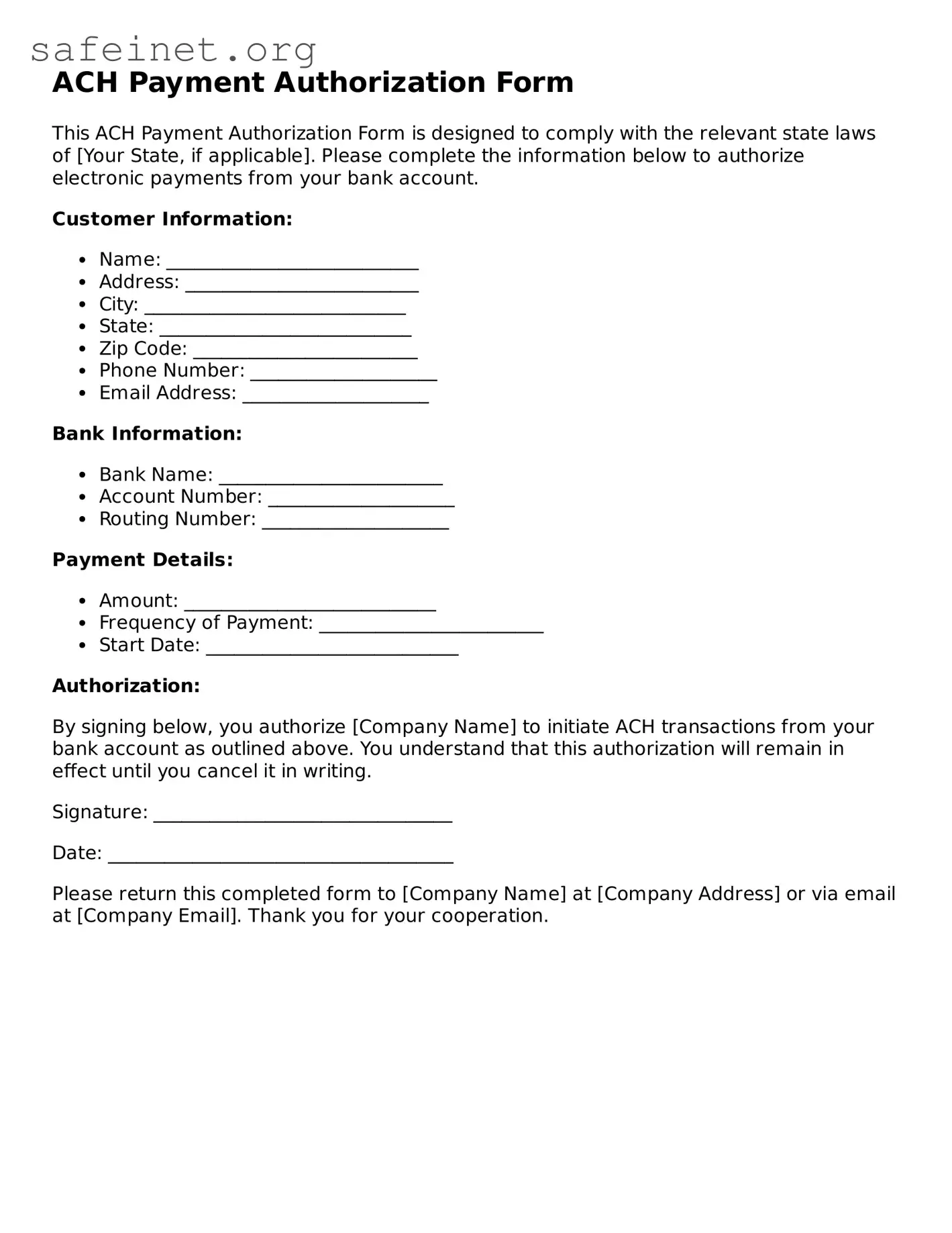The Direct Debit Authorization form operates similarly to the ACH Payment Authorization Form by allowing individuals to provide consent for automatic withdrawals from their bank accounts. Both documents require the account holder’s signature and banking details to ensure that funds are taken from the correct account. The main difference lies in the entity executing the withdrawals, as direct debit transactions can also involve third-party service providers in addition to banks, enhancing the scope of payment types and creditors involved.
The Electronic Funds Transfer (EFT) Agreement shares a strong resemblance to the ACH Payment Authorization Form in that both are designed to facilitate electronic payments directly from a bank account. Each form requires clear consent from the account holder and specific instructions regarding the amount and frequency of transactions. The distinction between these forms may depend on the types of transactions they govern; while ACH transactions typically encompass standard payments and payroll, EFT agreements may include a broader range of services like bill payments and peer-to-peer transfers.
A Bill Pay Authorization is another document that aligns closely with the ACH Payment Authorization Form. It allows customers to authorize a financial institution to handle bill payments on their behalf. While both documents involve consent for recurring payments, the Bill Pay Authorization focuses specifically on managing payments to service providers and utilities, rather than broader ACH transfers that may include various payment types, including payroll and vendor payments.
The Recurring Payment Authorization Form is nearly identical to the ACH Payment Authorization Form, as both facilitate consistent and scheduled withdrawals from a designated bank account. Both forms require the payer’s banking information and agreement to terms regarding the frequency and duration of payments. However, the Recurring Payment Authorization is typically more specific to subscriptions and memberships, whereas the ACH form can encompass a wider array of transactions.
The Credit Card Authorization Form mimics the ACH Payment Authorization Form in its intent to secure consent for automatic charges. While the ACH form deals predominantly with bank account debits, the Credit Card Authorization allows for automatic payments via credit cards. Each form necessitates personal information and a signature, but they differ in the financial instruments utilized—ACH focuses on bank transfers, while the credit card form leverages credit cards for payment processing.
The Loan Payment Authorization is comparable to the ACH Payment Authorization Form, as it also provides authorization for a lender to withdraw payments directly from a borrower’s bank account. Both forms require the borrower’s signature and banking details, ensuring that timely payments are received without further action from the borrower. However, the Loan Payment Authorization is specific to loans and financing agreements, while the ACH form is more versatile, accommodating various payment types such as services and payroll.
The Service Payment Authorization form serves a similar purpose to the ACH Payment Authorization Form by enabling businesses to withdraw payments for services directly from customer accounts. Both require authorization and banking details from the customer to perform the withdrawals. However, the Service Payment Authorization typically pertains to specific service agreements, whereas the ACH form can be utilized for a broader scope of transactions.
An Automatic Transfer Authorization is akin to the ACH Payment Authorization Form in that it provides approval for funds to be electronically moved from one account to another. Both versions necessitate a clear expression of consent and detailed information regarding the accounts involved. Unlike the ACH form, which can facilitate payments to various recipients, the Automatic Transfer Authorization is often used for transfers between an individual’s own accounts.
The Payroll Deduction Authorization is another document with similarities to the ACH Payment Authorization Form. This form permits an employer to withdraw specified amounts from an employee’s bank account for various purposes, such as contributions to retirement plans or benefit deductions. Both documents require informed consent and precise banking details, but they are particularly focused on employment-related transactions, contrasting the more general scope of the ACH authorization.
